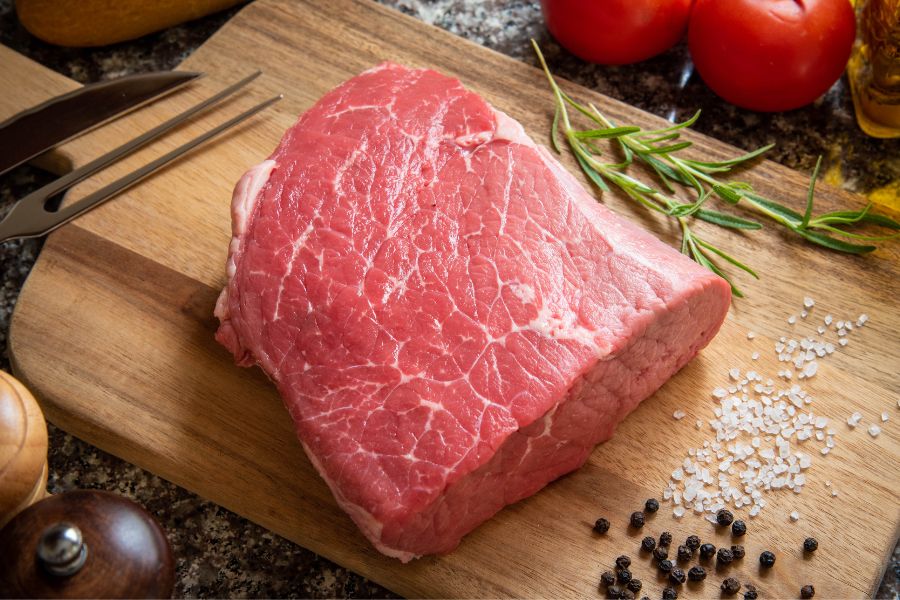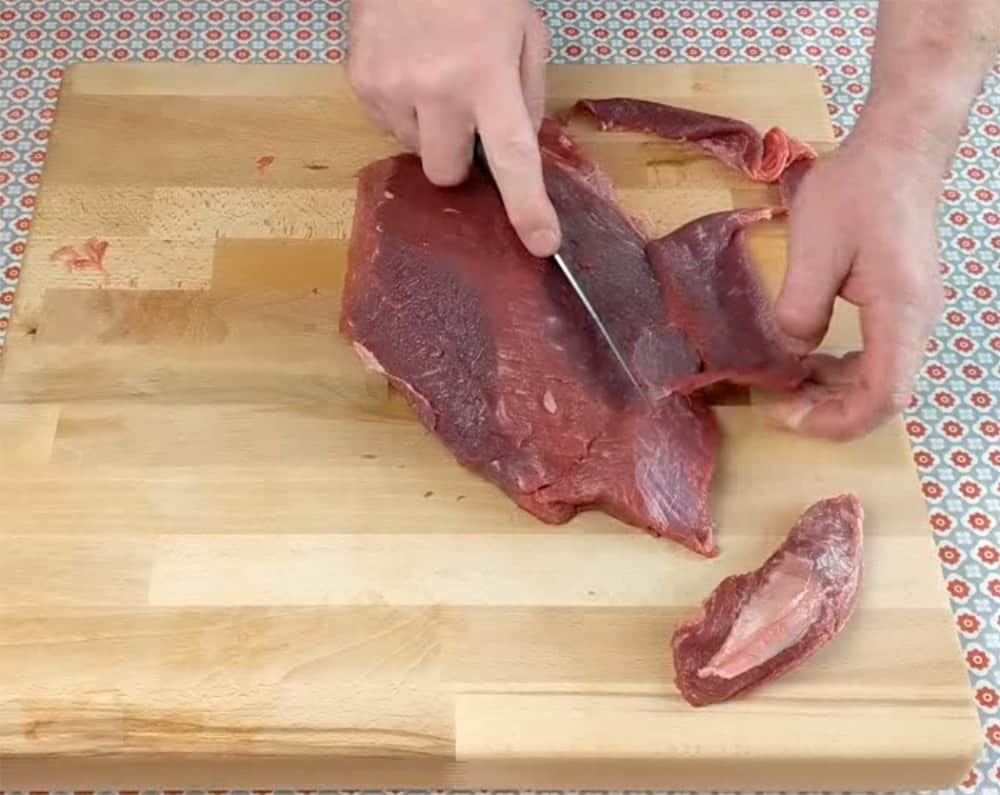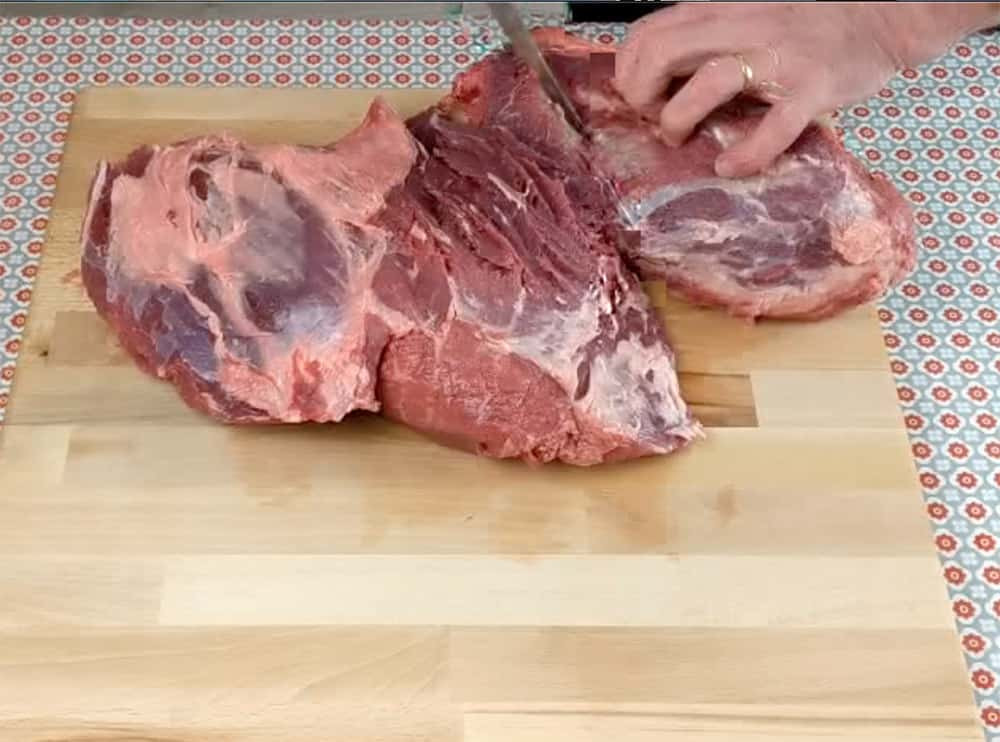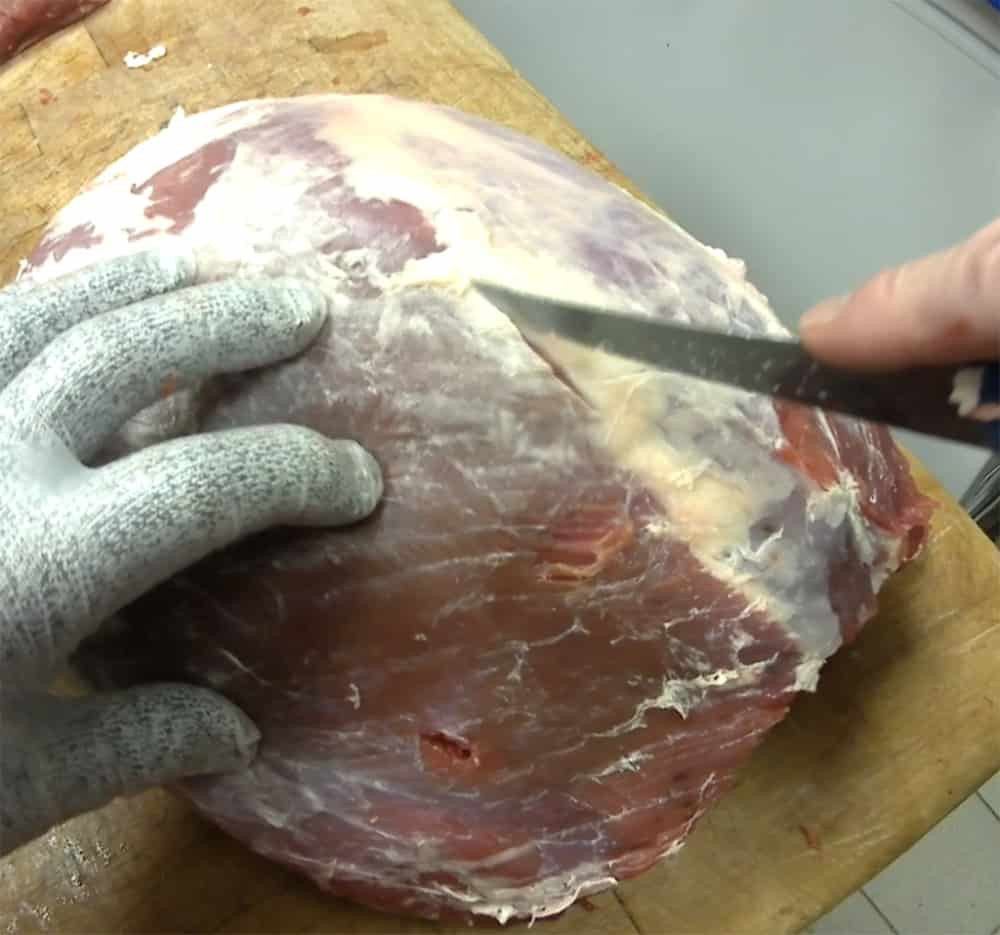The beef knuckle is a sub-primal from the beef round. It weighs from between 4 kg to 6. 5 kg, depending on the carcase weight.
It’s called the ball of the round, the sirloin tip, the round tip, the tip center (in the UK and Ireland), the thick flank, the beef ball tip roast, the sirloin tip roast, and the French roll roast. The names change from place to place. Confusing, isn’t it?.
Beef knuckle steak is an underrated cut that can be absolutely delicious when cooked properly This affordable cut is lean and flavorful, but it does require some special attention to turn out tender and juicy
With my simple step-by-step guide, you’ll learn everything you need to know to cook beef knuckle steak right at home. I’ll walk you through choosing the best cut, prepping and seasoning, as well as cooking techniques like searing, roasting, grilling and braising. Follow these tips and you’ll be rewarded with the perfect beef knuckle steak dinner.
What Exactly is Beef Knuckle Steak?
Before we dive into cooking, let’s look at what beef knuckle steak actually is. This cut comes from the round primal located near the rear of the cow. It’s sometimes labeled as sirloin tip roast ball tip roast or round tip roast.
The beef knuckle is a large, lean muscle that doesn’t have much marbling. While it’s not the most tender cut, it has great beefy flavor when prepared properly. It’s also budget-friendly, making it a smart choice for family meals.
When portioned into steaks, look for pieces that are 1-2 inches thick for the best results. Thinner cuts can dry out quickly.
Tips for Choosing the Best Beef Knuckle Steak
-
Pick steaks at least 1 inch thick – Thinner cuts will overcook too fast. Go for 1-2 inch portions.
-
Check the color – Bright red lean meat indicates fresher beef. Avoid brown or gray spots.
-
Look for some marbling – While knuckle is a lean cut, some thin marbling adds flavor and moisture.
-
Choose USDA Choice grade beef – This grade offers good marbling and tenderness at a reasonable price.
-
Get individual steaks, not stew meat – Cubed stew meat dries out faster. Stick to solid portions.
Prepping Beef Knuckle Steak for Cooking
Proper prep is key for cooking beef knuckle steak correctly. Here are my top tips:
-
Trim excess fat and silverskin – This tough membrane won’t break down during cooking. Cut it off.
-
Cut against the grain – Long muscle fibers get tough. Slicing across the grain shortens them.
-
Tenderize with a mallet – Gentle pounding helps break down tough connective tissue.
-
Marinate for added flavor – Soak in wine, citrus, vinegar, or spice rubs for 1-2 hours.
-
Bring to room temp before cooking – Cold beef seizes up when hit with heat. Let it gradually warm up.
Seasoning for Delicious Flavor
Beef knuckle steak needs robust seasoning to bump up the flavor. I recommend:
-
Salt and pepper – Generously season with kosher salt and cracked black pepper.
-
Garlic powder – This adds a tasty punch of flavor.
-
Onion powder – Complementary flavor that enhances the beefiness.
-
Smoked paprika – A small amount infuses meat with subtle smokiness.
-
Dried oregano or thyme – Earthy notes pair nicely with beef.
-
Worcestershire or soy sauce – Umami flavors intensify the savory taste.
Cooking Methods for Perfectly Cooked Steak
The cooking technique you choose can make or break your beef knuckle steak. Here are some excellent options:
Pan Searing
-
Use high heat – Get the pan very hot before adding oil. Cast iron works great.
-
Don’t crowd the pan – Cook steaks in a single layer with space between.
-
Sear both sides – Aim for a dark brown crust without burning. About 2-3 minutes per side.
Oven Roasting
-
Preheat to 325°F – Low, slow heat tenderizes while retaining moisture.
-
Add vegetables like carrots, onions, potatoes – Roasted veggies soak up the juices.
-
Use a meat thermometer – Cook until internal temp reaches 155°F for medium.
-
Let roast rest before slicing – Gives time for juices to redistribute.
Grilling
-
Get grill very hot – Cook over direct medium-high heat. Hot grates sear the meat.
-
Flip steak every 5 minutes – Frequent turning prevents charring.
-
Flip diagonally for grill marks – Rotate steak 45 degrees for aesthetic marks.
-
Let rest 5-10 minutes after – Crucial for tender, juicy steak off the grill.
Braising
-
Sear steak before braising – Browning adds deeper flavor.
-
Use small amount of liquid like broth – Too much liquid will make texture mushy.
-
Add veggies like onions, carrots, celery – They’ll soak up rich flavors.
-
Simmer on stove or bake in oven – Low, moist heat tenderizes steak.
Testing Steak Doneness
With lean cuts like knuckle steak, it’s extra important to nail the right level of doneness. Here’s how to test:
-
Use an instant read thermometer – Insert into thickest part without hitting bone.
-
Rare – 120-125°F
-
Medium Rare – 130-135°F
-
Medium – 140-145°F
-
Well Done – 155°F and above
-
Check color if no thermometer – Rare is bright red, well-done is brown throughout.
Letting Beef Knuckle Steak Rest
Finally, never skip the resting period after cooking. Here’s why it matters:
-
Redistributes juices – Resting allows moisture to absorb back into steak.
-
Prevents dryness – Cutting into steak right away loses all its juices.
-
Allows flavors to develop – During rest, seasonings and juices have time to soak in.
-
Makes slicing easier – Meat fibers relax, so steak slices neatly instead of shredding.
-
How long to rest? Beef knuckle steak benefits from a 10-20 minute rest time after cooking.

Muscles in the beef knuckle
The femur muscle
This is the muscle that connects to the thighbone. It has a lot of fat and gristle that needs to be cut away. It also has a layer of connective tissue from where it connected to the femur. When trimmed, this muscle is great for lean mince (ground beef).

The wedge muscle
This piece of beef is solid and lean. It has a thin layer of connective tissue on the outside and a thick layer of silverskin on the inside. When it is completely trimmed, there are many options for his cut. Diced for stews, casseroles, beef bourguignon. It’s great because you can slice it thinly for minute steaks, sandwich steaks, and Philly cheesesteaks, or you can cut it into strips for stir-frying or beef stroganoff. It is very lean, so you would need to add some fat to the outside before roasting it.

The bullet muscle
This is the best muscle of the group. If you roast it, you could add a layer of fat for flavor and moisture. The slices are pretty thin and wide, so it’s great for controlling your portions. The inter-muscle connective tissue does not need to be removed as it will melt during roasting.
The bullet can be further subdivided by cutting along the thin silver skin to make two smaller cuts. If you let these cuts age for 14 to 21 days, they become very tender and flavorful. If cut into thin strips, the thicker piece is as tender as some high-end steaks, and the thinner piece makes great beef strips for stir-fry. Using a Jaccard tenderizer on steaks is a good way to break down the meat’s fibers before cooking them. The machine has 48 needle-pointed blades that cut through muscle, making the meat softer against the teeth and more enjoyable to eat. The Jaccard tenderization also lets more of the marinade get into the meat, which makes the finished product taste much better.

What is the beef knuckle?
The beef knuckle is a very versatile beef sub-primal cut and a great source of lean beef.

There are four main muscles in the Beef Knuckle.
- Rectus femoris
- Vastus intermedius
- Vastus lateralis
- Vastus medialis.
Rectus femoris, vastus lateralis, and vastus intermedius are the muscles that make up the thigh. In the US, these muscles are called the tip center, tip side, and tip bottom.
I mention them here for completeness, but in the real world, we use everyday terms.
However, these muscles are known by different names in each country, which can be hard to keep track of. I’ll use photographs to give a better understanding of what it is we are talking about.

Beef Knuckle | How to cut and trim ☺︎
How long do you cook a beef knuckle?
Place the beef knuckle in a roasting pan with onions, carrots, and peppers. Add up to 1 cup of water (or broth) depending on the size of the roast. Cook for about 45 minutes (it will need 30 minutes per pound) at 325 degrees Fahrenheit. No need to cover the roast, as you want the meat to brown and crisp on top.
How do you cook a beef knuckle steak?
If you’re in the mood for steak, look no further. Slice beef knuckle into thick steaks, season them to your liking, and sear them in a hot skillet with butter or oil. The result is a delectable beef knuckle steak that’s tender and bursting with flavor. Pair it with classic steakhouse sides for a gourmet experience.
How much does a beef knuckle weigh?
It weighs from between 4 kg to 6.5 kg, depending on the carcase weight. The knuckle goes by many names: The ball of the round, sirloin tip, round tip, tip center (centre in UK and Ireland) and sometimes thick flank, beef ball tip roast, sirloin tip roast and French roll roast (there are different names around the world). Confusing, isn’t it?
Can Beef knuckle be cooked like steak?
Beef knuckle can be cooked similarly to steak, as it is a versatile cut of meat that can be used in various dishes such as roasts, stews, kebabs, and grilled steaks. Additionally, it can be thinly sliced for use as cold cuts or in Philly cheesesteaks.
